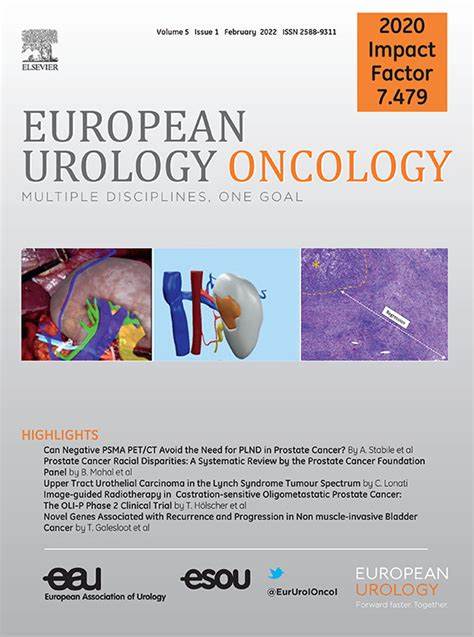Two-fraction Versus Five-fraction Stereotactic Body Radiotherapy for Intermediate-risk Prostate Cancer: The TOFFEE Meta-analysis of Individual Patient Data from Four Prospective Trials
IF 8.3
1区 医学
Q1 ONCOLOGY
引用次数: 0
Abstract
Background and objective
Recent randomized controlled trials have demonstrated the efficacy of five-fraction stereotactic body radiotherapy (5F-SBRT) for prostate cancer (PC), but there is no comparative evidence for fewer fractions. We compare outcomes of prostate two-fraction SBRT (2F-SBRT) and 5F-SBRT using prospective data for patients with intermediate-risk (IR) PC.
Methods
This meta-analysis of individual patient data evaluated IR-PC from four prospective trials of prostate SBRT (two trials each of 2F- and 5F-SBRT). The primary endpoint was the cumulative incidence of biochemical failure (BCF). Secondary endpoints included the cumulative incidence of distant metastases (DM) and patient-reported quality of life (QoL).
Key findings and limitations
Of the 199 patients meeting the eligibility criteria, 143 (72%) were in the 5F-SBRT group and 56 (28%) were in the 2F-SBRT group. Median follow-up was 9.4 years. There was no significant difference in BCF with a 5-year cumulative incidence of 3.6% (95% CI 0–8.6%) in the 2F-SBRT group and 6.0% (95% CI 1.8–10.2%) in the 5F-SBRT group (p = 0.73). There was no significant difference in DM incidence. We found no differences in acute and late urinary or bowel QoL. Limitations include the non-randomized comparison.
Conclusions and clinical implications
We report the first prospective comparison of prostate 2F-SBRT and 5F-SBRT. We found no significant difference in efficacy, or in urinary or bowel QoL. This meta-analysis further encourages the potential of 2F-SBRT to be a standard-of-care option for IR PC.
二分式立体定向放疗与五分式立体定向放疗治疗中危前列腺癌:四项前瞻性试验个体患者数据的太妃糖荟萃分析
背景和目的:最近的随机对照试验已经证明了五分量立体定向放疗(5F-SBRT)治疗前列腺癌(PC)的疗效,但没有更少分量的比较证据。我们比较了前列腺二段式SBRT (2F-SBRT)和5F-SBRT对中危(IR) PC患者的预后。方法:本荟萃分析对前列腺SBRT的四项前瞻性试验(2F- SBRT和5F-SBRT各两项试验)的个体患者数据进行了IR-PC评估。主要终点是生化失败(BCF)的累积发生率。次要终点包括远处转移的累积发生率(DM)和患者报告的生活质量(QoL)。主要发现和局限性:199例符合资格标准的患者中,143例(72%)属于5F-SBRT组,56例(28%)属于2F-SBRT组。中位随访时间为9.4年。2F-SBRT组的5年累积发病率为3.6% (95% CI 0-8.6%), 5F-SBRT组的5年累积发病率为6.0% (95% CI 1.8-10.2%),两者无显著差异(p = 0.73)。两组糖尿病发病率无显著差异。我们发现急性和晚期尿或肠生活质量没有差异。局限性包括非随机比较。结论和临床意义:我们报道了前列腺2F-SBRT和5F-SBRT的首次前瞻性比较。我们没有发现疗效、泌尿和肠道生活质量有显著差异。这项荟萃分析进一步鼓励2F-SBRT成为IR PC的标准治疗选择。
本文章由计算机程序翻译,如有差异,请以英文原文为准。
求助全文
约1分钟内获得全文
求助全文
来源期刊

European urology oncology
Multiple-
CiteScore
15.50
自引率
2.40%
发文量
128
审稿时长
20 days
期刊介绍:
Journal Name: European Urology Oncology
Affiliation: Official Journal of the European Association of Urology
Focus:
First official publication of the EAU fully devoted to the study of genitourinary malignancies
Aims to deliver high-quality research
Content:
Includes original articles, opinion piece editorials, and invited reviews
Covers clinical, basic, and translational research
Publication Frequency: Six times a year in electronic format
 求助内容:
求助内容: 应助结果提醒方式:
应助结果提醒方式:


